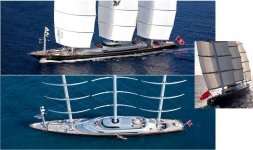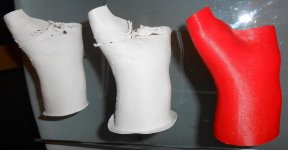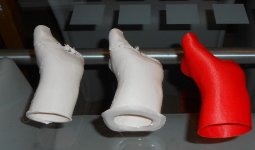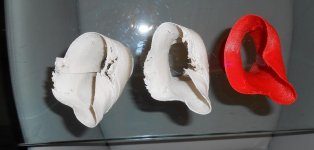I follow the evolution of 3D printing through reading for some years now and I guess it is time to think over practicing with this exciting new fabrication method/tool.
I would like participants to provide useful links, relevant information or develop a tutorial over how one diyer can start with 3D printing at home for to practice printing small size parts which can be useful to his hobby, what will he need (knowledge, capabilities minimum equipment) and how he should proceed.
George
I would like participants to provide useful links, relevant information or develop a tutorial over how one diyer can start with 3D printing at home for to practice printing small size parts which can be useful to his hobby, what will he need (knowledge, capabilities minimum equipment) and how he should proceed.
George
You can only print mechanical parts...
Used all forms of 3D rapid prototyping in the past, the new desktop FDM devices are rather nice...did use a much bigger one where the model was kept at an elevated temperature during the build process, and also had a support plastic that allowed over hands and other complex 3D shapes that require structural support...
For small home printing, you need some form of 3D design package so you can create the 3D models to print...
The way the design is printed and design features will need to be thought about, because as stated you have no real way of supporting overhands during the printing process...keep models simple and thing how the structure will support its self during the build. Best orientation to build the model in, this also relates to the strength of the build, across the layers fractures can easily form, so you have to orientate load bearing structures so they avoid the week inter layer joints where there will be stress.
Solid thick wall designs are best, but quite intricate designs can be done, again playing and getting a feel for how a part will print and work in the real world is part of the learning process.
Using wet and dry in a bath of water is a good way of smoothing the ridged edges of the finished model.
We had something similar to this...
http://www.stratasys.com/~/media/Main/Secure/White Papers/Rebranded/SSYS_WP_3d_printing_with_fdm.pdf
Used all forms of 3D rapid prototyping in the past, the new desktop FDM devices are rather nice...did use a much bigger one where the model was kept at an elevated temperature during the build process, and also had a support plastic that allowed over hands and other complex 3D shapes that require structural support...
For small home printing, you need some form of 3D design package so you can create the 3D models to print...
The way the design is printed and design features will need to be thought about, because as stated you have no real way of supporting overhands during the printing process...keep models simple and thing how the structure will support its self during the build. Best orientation to build the model in, this also relates to the strength of the build, across the layers fractures can easily form, so you have to orientate load bearing structures so they avoid the week inter layer joints where there will be stress.
Solid thick wall designs are best, but quite intricate designs can be done, again playing and getting a feel for how a part will print and work in the real world is part of the learning process.
Using wet and dry in a bath of water is a good way of smoothing the ridged edges of the finished model.
We had something similar to this...
http://www.stratasys.com/~/media/Main/Secure/White Papers/Rebranded/SSYS_WP_3d_printing_with_fdm.pdf
Thank you Marce.
I read the paper, I went to the manufacturer site where there are more papers to read, which I did.
Going from one link to another, I found these three links, the content of which cleared up many things in my mind:
101 https://www.youtube.com/watch?v=g9H_AdtGf0g
201 https://www.youtube.com/watch?v=82WXI9IGduM&spfreload=1
301 https://www.youtube.com/watch?v=ikXNseLG4so
My main question in the beginning was what drawing sw is compatible with the 3D printers. What I have seen so far is that any drawing sw that can produce .stl files is good to go.
Today, instead of inputing the shape of an object through engineering drawing only, we can use an optical or laser scanner to scan the object and produce a software image by which they feed the 3D printer, so we can replicate and scale objects. Cost of 3D scanners is btn 400$ and 1000$. I am sure that a year later the price of such devices will have dropped to some 1/3
Entry level 3D printers start from ~500$. There are some in kit form for ~350
e.g. https://www.youtube.com/watch?v=RrOt4R-kR2g
fas42, there are many mechanical functioning things which I would like to build myself.
The important thing is to get into it, build some confidence of the process and then proceed to build the desired objects.
George
I read the paper, I went to the manufacturer site where there are more papers to read, which I did.
Going from one link to another, I found these three links, the content of which cleared up many things in my mind:
101 https://www.youtube.com/watch?v=g9H_AdtGf0g
201 https://www.youtube.com/watch?v=82WXI9IGduM&spfreload=1
301 https://www.youtube.com/watch?v=ikXNseLG4so
My main question in the beginning was what drawing sw is compatible with the 3D printers. What I have seen so far is that any drawing sw that can produce .stl files is good to go.
Today, instead of inputing the shape of an object through engineering drawing only, we can use an optical or laser scanner to scan the object and produce a software image by which they feed the 3D printer, so we can replicate and scale objects. Cost of 3D scanners is btn 400$ and 1000$. I am sure that a year later the price of such devices will have dropped to some 1/3
Entry level 3D printers start from ~500$. There are some in kit form for ~350
e.g. https://www.youtube.com/watch?v=RrOt4R-kR2g
fas42, there are many mechanical functioning things which I would like to build myself.
The important thing is to get into it, build some confidence of the process and then proceed to build the desired objects.
George
Last edited:
These will be very useful, I have a few bags of assorted sizes...
http://www.pemnet.com/fastening_products/pdf/sidata.pdf
http://www.pemnet.com/fastening_products/pdf/sidata.pdf
I wish, the build envelope isn't big enough. But what could be made is a tweeter mount with a built in horn. What we did use the machine for is building proto-type enclosures for form and fit purposes. The finished enclosures were investment casted, so we modelled heat sinking into the cases with the hot components either bolted direct to the case or for SMD devices pressed against the case with thermal pads between them. Some would also have active heat sinking with heat pipes to move heat to the outer casing.
Once you start playing the opportunities to use the printer just keep coming...need a temporary assembly or test jig, just model it and print it out, want to create some bespoke knobs for your next amp, just design and print.
I've used Inventor and solidworks since 2003 for doing the 3D side of things and by using the IDF interface from my PCB package I can build a full 3D assembly, check for fit and interference, but with a 3D print you can also handle the design and check that a human can assemble it (3D design can allow you to design things which cannot be hand assembles if you aren't careful.
Also parts the you cant get anymore can be reversed engineered and re-built, the uses are endless.
Once you start playing the opportunities to use the printer just keep coming...need a temporary assembly or test jig, just model it and print it out, want to create some bespoke knobs for your next amp, just design and print.
I've used Inventor and solidworks since 2003 for doing the 3D side of things and by using the IDF interface from my PCB package I can build a full 3D assembly, check for fit and interference, but with a 3D print you can also handle the design and check that a human can assemble it (3D design can allow you to design things which cannot be hand assembles if you aren't careful.
Also parts the you cant get anymore can be reversed engineered and re-built, the uses are endless.
Today, instead of inputing the shape of an object through engineering drawing only, we can use an optical or laser scanner to scan the object and produce a software image by which they feed the 3D printer, so we can replicate and scale objects.
After weeks of attempting to accurately model from different angle photographs (Autodesk software), my g/f gave up and decided to buy a scanning cabin.
(for thin-walled objects, part of the problem with 3D printing companies here, is their lack of knowledge of the material mechanics side)
Make a set of headphones. or a christmas present.
or that classic car part that no one has anymore and is made from plastic.
or plastic transformer vibration absorption dampers for you know the snake oil crowd.
or a customized logo.
You know I can't think of anything audio would have to gain from a 3D printer aside from a few PCB cases that we can already get now.
Brackets, that would be a useful purpose for audio, brackets for mounting capacitors or PCB boards at odd angles.
or that classic car part that no one has anymore and is made from plastic.
or plastic transformer vibration absorption dampers for you know the snake oil crowd.
or a customized logo.
You know I can't think of anything audio would have to gain from a 3D printer aside from a few PCB cases that we can already get now.
Brackets, that would be a useful purpose for audio, brackets for mounting capacitors or PCB boards at odd angles.
Last edited:
After weeks of attempting to accurately model from different angle photographs (Autodesk software), my g/f gave up and decided to buy a scanning cabin.
At St.Petersburg Polytechnic University they were developing such a sw with still images for some years now . They have commercialised the sw, I don’t know under which brand name, probably it’s “Hard ‘n’ Soft” marketing it.
And here is a dedicated laser scanner for small objects
MakerBot Digitizer | 3D Scanner | MakerBot Europe
For large objects and serious job, please contact Faro
(for thin-walled objects, part of the problem with 3D printing companies here, is their lack of knowledge of the material mechanics side)
Stacking up layers one over the other doesn’t make mechanical load bearing homogenous across the printed mass, yes?
This afternoon, as we went for a walk around Piraeus bay, we had the pleasure to watch the ‘Maltese Falcon’ (Perini Navi) and I thought about you (Pavlovian reflex)
George
Attachments
I have an interest in phase plugs for compression driversMake a set of headphones. or a christmas present.
or that classic car part that no one has anymore and is made from plastic.
or plastic transformer vibration absorption dampers for you know the snake oil crowd.
or a customized logo.
You know I can't think of anything audio would have to gain from a 3D printer aside from a few PCB cases that we can already get now.
Brackets, that would be a useful purpose for audio, brackets for mounting capacitors or PCB boards at odd angles.
I'd sooner invest the money in something that can move a milling cutter or router in 3 dimensions. If you can't machine the thing directly, you can probably make a mold and cast it.
Supposedly there's free software that can use a set of digital photos to create a 3D model. It can't be very precise, but the idea of scaling 3D objects up or down is intriguing.
Supposedly there's free software that can use a set of digital photos to create a 3D model. It can't be very precise, but the idea of scaling 3D objects up or down is intriguing.
Stacking up layers one over the other doesn’t make mechanical load bearing homogenous across the printed mass, yes?
3D printers also have a hard time with the combination of warped surfaces and large curvature changes.
See for example a wrist brace, printed in 3 different plastics.
The rough spots on the inside and outside are the result of surface peak anomalies in the model.
This one was calculated from different angle images, the screen image of the model doesn't show these peaks.
One would have to smoothen the model at numerical level, to remove them. Also a downside of modelling from digital images with current available software, makes a scanning cabin more rapidly pay off its expenditure.
Contemporary yacht/ship hull software is much more refined, almost makes me forget all of yesteryears cursing. Almost !

[ I was offered the opportunity to board the Maltese Falcon for a complete rundown/tour a number of years ago, when it's was in NL for a refit, regret not haven taken it.
I liked the Perini designs long before they started building the large ones, e.g. the 36m Gitana that was launched in the late '80s, used in the movie Hitch. (currently offered for sale, btw).
A real estate guy from here managed to sell his 184' Perini Navi a week ago, all-alloy Salute, sloop rigged with a 235' mast.
€10M write-off in half a decade, he has yet to sell his 120' Heesen built Duketown (= name of his city in the south during the annual jazz week).
Buying an expensive yacht, almost finished and at a discount, right before the bubbles pop in '08 can be quite painful.]
Attachments
- Status
- This old topic is closed. If you want to reopen this topic, contact a moderator using the "Report Post" button.
- Home
- General Interest
- Everything Else
- 3D printing for diy-ing




